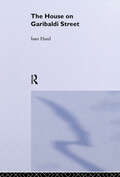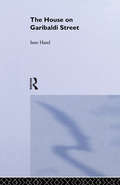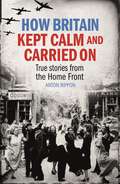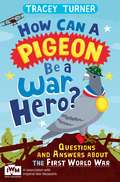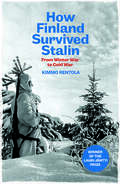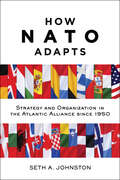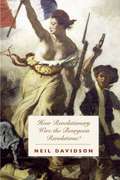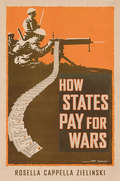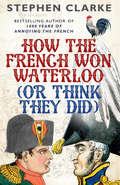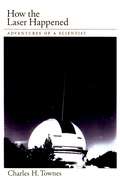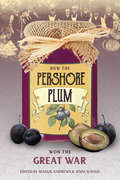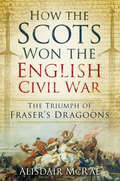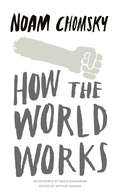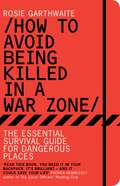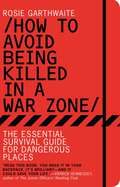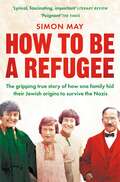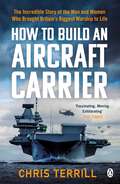- Table View
- List View
The House on Garibaldi Street
by Isser HarelThis is the true story of the kidnapping of Adolf Eichmann in Argentina by the Mossad, Israel's secret intelligence serviceunder the leadership of Isser Harel. This is his account, revised and updated, with the real names and details of all Mossad personnel.
The House on Garibaldi Street
by Isser HarelThis is the true story of the kidnapping of Adolf Eichmann in Argentina by the Mossad, Israel's secret intelligence serviceunder the leadership of Isser Harel. This is his account, revised and updated, with the real names and details of all Mossad personnel.
The House on the Lake: Read the new spellbinding thriller from the bestselling author of Day of the Accident
by Nuala EllwoodNo matter how far you run . . .He's never far behind'Gripping, poignant' Rosamund Lupton'Eerily haunting' Jane Corry'I literally couldn't put it down' Emma Curtis__________________________________________Lisa needs to disappear. And her friend's rambling old home in the wilds of Yorkshire seems like the perfect place. It's miles away from the closest town, and no one there knows her or her little boy, Joe.But when a woman from the local village comes to visit them, Lisa realizes that she and Joe aren't as safe as she thought.What secrets have Rowan Isle House - and her friend - kept hidden all these years?And what will Lisa have to do to survive, when her past finally catches up with her?**BUY THE NEW SPELLBINDING THRILLER FROM THE BESTSELLING AUTHOR OF DAY OF THE ACCIDENTAND MY SISTER'S BONES**__________________________________________WHAT THEY'RE SAYING ABOUT NUALA ELLWOOD'Rivals The Girl on the Train (and beats it for style)' Observer'From start to finish this exciting thriller kept you guessing. What a page turner with all the unexpected twists right until the end...A thoroughly good read' Netgalley Reviewer'Brilliantly compulsive and with one hell of a twist!' Claire Douglas'Ellwood instantly creates a creepy, intense atmosphere...it is utter perfection' Netgalley Reader'Makes you question everything you thought you knew' Emma Kavanagh'What a great book! It's got everything a good thriller needs, a creepy old house, a remote location, some great complex characters and lots of perfectly timed twists and turns' Netgalley Reader'You won't see the big twist coming in this haunting thriller' Daily Express'Compelling characters and an often heart wrenching narrative' Netgalley Reader'Creepy and deliciously atmospheric, this page-turner has it all - twists and turns and a powerful emotional punch' Teresa Driscoll'Perfectly paced, Nuala takes the reader down a mysterious and gripping path of intrigue and builds the characters with such beautiful depth' Netgalley Reader
How America Goes to War (Modern Military Tradition)
by Frank E. VandiverWith American involvement in Iraq in the forefront of national news coverage and in the minds of many citizens, questions concerning America's involvement in past conflicts have once again arisen. This is the story of how the United States has gone to war and how the evolution of the nation's war-making apparatus has mirrored the nation's rise to global power. It focuses on the president's role as commander-in-chief vis-a-vis Congress from George Washington to George W. Bush. Conflicts range from the War of 1812 to the Mexican and Civil Wars, the two World Wars, conflicts in Southeast Asia, and recent wars in the Middle East. Topics include Congress's role in various wars, the evolution of the War Department to the Department of Defense, as well as developments in weapons, tactics, and strategy.Wars have played an integral role in America's transformation from a continental power into a world force. Over time, America's war making has favored and continues to favor the expansion of the President's role at the expense of the Congress. America's future will be determined in large part by the way in which the nation chooses and engages in military pursuits. Questions about how and when we go to war have never been so vital or relevant. This thought-provoking one volume overview serves as a quick introduction to these important issues.
How Britain Kept Calm and Carried On: True stories from the Home Front
by Anton RipponThe British are well known for their unique sense of humour - for the ability to see the funny side even in the most dire situation - and it was that humour that helped the nation through the dark days of the Second World War. In this heartwarming, often amusing and sometimes heartbreakingly sad book, Anton Rippon has gathered together stories from people all over the country that reveal the strange, incredible and downright funny things that happened to them between 1939 and 1945. From the Blitz to the Home Guard, blackouts to unexploded bombs, service life at home and abroad, there are stories here from all walks of life and from men, women and children of the time. Their first-person stories stand testament to that indomitable spirit that 'kept us calm and carrying on' through those darkest days.
How Can a Pigeon Be a War Hero? And Other Very Important Questions and Answers About the First World War: Published in Association with Imperial War Museums
by Tracey TurnerWhy did the First World War start? Who was fighting who? Did soldiers still fight with swords? Had aeroplanes been invented yet? What was it like to be inside the first tank sent to war? How could a shaving brush help you escape being captured? Did animals fight in the war? How can a pigeon be a war hero? What was the Women's Land Army? Why did it go on so long? How did it end? Find out the answers to these and lots of other exciting questions in How Can a Pigeon Be a War Hero? And Other Very Important Questions and Answers About the First World War. Published in association with the Imperial War Museum, Tracey Turner's brilliantly informative book will tell you everything you ever needed to know about World War I.
How Finland Survived Stalin: From Winter War to Cold War, 1939-1950
by Kimmo RentolaA dramatic and timely account of Stalin’s failed invasion of Finland in 1939, and the decade of wars and fraught relations that followed In November 1939, Stalin directed his military leaders to launch an invasion of Finland. In what became known as the Winter War, the full might of the Soviet army was pitted against this small Nordic republic. Yet despite their vastly superior military strength, the Soviets suffered heavy losses and failed to mount Stalin’s intended full-scale invasion. How did Finland evade Stalin’s crosshairs—not once, but three times more? In this groundbreaking account, Kimmo Rentola traces the epochal shifts in Soviet-Finnish relations. From the Winter War to Finland’s exit from World War II in 1944, a possible Soviet-backed coup in 1948, and Moscow’s designation of Finland as an enemy state in 1950, Finland was forced to navigate Stalin’s outsize political and territorial demands. Rentola presents a dramatic reconstruction of Finland’s unlikely survival at a time when the nation’s very existence was at stake.
How Many Miles to Babylon?: A Novel (Penguin Essentials Ser. #63)
by Jennifer JohnstonAs a child Alec, heir to the big house and only son of a bitter marriage, formed a close friendship with Jerry, a village boy who shared his passion for horses. In 1914 both enlisted in the British Army – Alec goaded by his beautiful, cold mother to fight for King and Country, Jerry to learn his trade for the Irish Nationalist cause. But amid the mud of Flanders, their relationship is tested by an ordeal beyond the horror of the battlefield…
How NATO Adapts: Strategy and Organization in the Atlantic Alliance since 1950 (The Johns Hopkins University Studies in Historical and Political Science #132)
by Seth A. JohnstonToday;€™s North Atlantic Treaty Organization, with nearly thirty members and a global reach, differs strikingly from the alliance of twelve created in 1949 to "keep the Americans in, the Russians out, and the Germans down." These differences are not simply the result of the Cold War;€™s end, 9/11, or recent twenty-first-century developments but represent a more general pattern of adaptability first seen in the incorporation of Germany as a full member of the alliance in the early 1950s. Unlike other enduring post;€“World War II institutions that continue to reflect the international politics of their founding era, NATO stands out for the boldness and frequency of its transformations over the past seventy years.In this compelling book, Seth A. Johnston presents readers with a detailed examination of how NATO adapts. Nearly every aspect of NATO;¢;‚¬;€?including its missions, functional scope, size, and membership;¢;‚¬;€?is profoundly different than at the organization;€™s founding. Using a theoretical framework of "critical junctures" to explain changes in NATO;€™s organization and strategy throughout its history, Johnston argues that the alliance;€™s own bureaucratic actors played important and often overlooked roles in these adaptations. Touching on renewed confrontation between Russia and the West, which has reignited the debate about NATO;€™s relevance, as well as a quarter century of post;€“Cold War rapprochement and more than a decade of expeditionary effort in Afghanistan, How NATO Adapts explores how crises from Ukraine to Syria have again made NATO;€™s capacity for adaptation a defining aspect of European and international security. Students, scholars, and policy practitioners will find this a useful resource for understanding NATO, transatlantic relations, and security in Europe and North America, as well as theories about change in international institutions.
How NATO Adapts: Strategy and Organization in the Atlantic Alliance since 1950 (The Johns Hopkins University Studies in Historical and Political Science #132)
by Seth A. JohnstonToday;€™s North Atlantic Treaty Organization, with nearly thirty members and a global reach, differs strikingly from the alliance of twelve created in 1949 to "keep the Americans in, the Russians out, and the Germans down." These differences are not simply the result of the Cold War;€™s end, 9/11, or recent twenty-first-century developments but represent a more general pattern of adaptability first seen in the incorporation of Germany as a full member of the alliance in the early 1950s. Unlike other enduring post;€“World War II institutions that continue to reflect the international politics of their founding era, NATO stands out for the boldness and frequency of its transformations over the past seventy years.In this compelling book, Seth A. Johnston presents readers with a detailed examination of how NATO adapts. Nearly every aspect of NATO;¢;‚¬;€?including its missions, functional scope, size, and membership;¢;‚¬;€?is profoundly different than at the organization;€™s founding. Using a theoretical framework of "critical junctures" to explain changes in NATO;€™s organization and strategy throughout its history, Johnston argues that the alliance;€™s own bureaucratic actors played important and often overlooked roles in these adaptations. Touching on renewed confrontation between Russia and the West, which has reignited the debate about NATO;€™s relevance, as well as a quarter century of post;€“Cold War rapprochement and more than a decade of expeditionary effort in Afghanistan, How NATO Adapts explores how crises from Ukraine to Syria have again made NATO;€™s capacity for adaptation a defining aspect of European and international security. Students, scholars, and policy practitioners will find this a useful resource for understanding NATO, transatlantic relations, and security in Europe and North America, as well as theories about change in international institutions.
How Revolutionary were the Bourgeois Revolutions? (PDF)
by Neil DavidsonIn this panoramic historical analysis, Neil Davidson defends a renovated concept of bourgeois revolution. Davidson shows how globalised societies of the present are the result of a contested, turbulent history marked by often forceful revolutions directed against old social orders, from the Dutch Revolt to the English and American Civil Wars and beyond.
How States Pay for Wars
by Rosella Cappella ZielinskiArmies fight battles, states fight wars. To focus solely on armies is to neglect the broader story of victory and defeat. Military power stems from an economic base, and without wealth, soldiers cannot be paid, weapons cannot be procured, and food cannot be bought. War finance is among the most consequential decisions any state makes: how a state finances a war affects not only its success on the battlefield but also its economic stability and its leadership tenure. In How States Pay for Wars, Rosella Cappella Zielinski clarifies several critical dynamics lying at the nexus of financial and military policy.Cappella Zielinski has built a custom database on war funding over the past two centuries, and she combines those data with qualitative analyses of Truman’s financing of the Korean War, Johnson’s financing of the Vietnam War, British financing of World War II and the Crimean War, and Russian and Japanese financing of the Russo-Japanese War. She argues that leaders who attempt to maximize their power at home, and state power abroad, are in a constant balancing act as they try to win wars while remaining in office. As a result of political risks, they prefer war finance policies that meet the needs of the war effort within the constraints of the capacity of the state.
How the French Won Waterloo - or Think They Did
by Stephen ClarkePublished in the 200th Anniversary year of the Battle of Waterloo a witty look at how the French still think they won, by Stephen Clarke, author of 1000 Years of Annoying the French and A Year in the Merde.Two centuries after the Battle of Waterloo, the French are still in denial.If Napoleon lost on 18 June 1815 (and that's a big 'if'), then whoever rules the universe got it wrong. As soon as the cannons stopped firing, French historians began re-writing history. The Duke of Wellington was beaten, they say, and then the Prussians jumped into the boxing ring, breaking all the rules of battle. In essence, the French cannot bear the idea that Napoleon, their greatest-ever national hero, was in any way a loser. Especially not against the traditional enemy – les Anglais.Stephen Clarke has studied the French version of Waterloo, as told by battle veterans, novelists, historians – right up to today's politicians, and he has uncovered a story of pain, patriotism and sheer perversion ...
How the Holocaust Looks Now: International Perspectives
by M. Davies C. SzejnmannThis collection offers a series of essays that explore the historical culture the holocaust has engendered in Europe, Israel and the USA, the politics of its reception and representation, the motivations for and effectiveness of commemorating it, and the creative and didactic practices it has generated in contemporary literature, art, and thought.
How the Laser Happened: Adventures of a Scientist
by Charles H. TownesIn How the Laser Happened, Nobel laureate Charles Townes provides a highly personal look at some of the leading events in twentieth-century physics. Townes was inventor of the maser, of which the laser is one example; an originator of spectroscopy using microwaves; and a pioneer in the study of gas clouds in galaxies and around stars. Throughout his career he has also been deeply engaged with issues outside of academic research. He worked on applied research projects for Bell Labs; served on the board of directors for General Motors; and devoted extensive effort to advising the government on science, policy, and defense. This memoir traces his multifaceted career from its beginnings on the family farm in South Carolina. Spanning decades of ground-breaking research, the book provides a hands-on description of how working scientists and inventors get their ideas. It also gives a behind-the-scenes look at the scientific community, showing how scientists respond to new ideas and how they approach a variety of issues, from priority and patents to the social and political implications of their work. In addition, Townes touches on the sociology of science, uncovering some of the traditions and values that are invisible to an outsider. A towering and energetic figure, Townes has explored or pioneered most of the roles available to the modern scientist. In addition to fundamental research, he was actively involved in the practical uses of the laser and in the court cases to defend the patent rights. He was a founding member of the Jasons, an influential group of scientists that independently advises the government on defense policy, and he played an active part in scientific decisions and policies from the Truman through the Reagan administration. This lively memoir, packed with first-hand accounts and historical anecdotes, is an invaluable resource for anyone interested in the history of science and an inspiring example for students considering scientific careers.
How the Laser Happened: Adventures of a Scientist
by Charles H. TownesIn How the Laser Happened, Nobel laureate Charles Townes provides a highly personal look at some of the leading events in twentieth-century physics. Townes was inventor of the maser, of which the laser is one example; an originator of spectroscopy using microwaves; and a pioneer in the study of gas clouds in galaxies and around stars. Throughout his career he has also been deeply engaged with issues outside of academic research. He worked on applied research projects for Bell Labs; served on the board of directors for General Motors; and devoted extensive effort to advising the government on science, policy, and defense. This memoir traces his multifaceted career from its beginnings on the family farm in South Carolina. Spanning decades of ground-breaking research, the book provides a hands-on description of how working scientists and inventors get their ideas. It also gives a behind-the-scenes look at the scientific community, showing how scientists respond to new ideas and how they approach a variety of issues, from priority and patents to the social and political implications of their work. In addition, Townes touches on the sociology of science, uncovering some of the traditions and values that are invisible to an outsider. A towering and energetic figure, Townes has explored or pioneered most of the roles available to the modern scientist. In addition to fundamental research, he was actively involved in the practical uses of the laser and in the court cases to defend the patent rights. He was a founding member of the Jasons, an influential group of scientists that independently advises the government on defense policy, and he played an active part in scientific decisions and policies from the Truman through the Reagan administration. This lively memoir, packed with first-hand accounts and historical anecdotes, is an invaluable resource for anyone interested in the history of science and an inspiring example for students considering scientific careers.
How the Pershore Plum Won the Great War
by Professor Maggie Andrews Jenni WaughThe First World War was won not just on the battlefields but on the Home Front, by the men, women and children left behind. This book explores the lives of the people of Pershore and the surrounding district in wartime, drawing on their memories, letters, postcards, photographs, leaflets and recipes to demonstrate how their hard work in cultivating and preserving fruit and vegetables helped to win the Great War. Pershore plums were used to make jam for the troops; but ensuring these and other fruits and vegetables were grown and harvested required the labour of land girls, Boy Scouts, schoolchildren, Irish labourers and Belgian refugees. When submarine warfare intensified, food shortages occurred and it became vital for Britain to grow more and eat less food. Housewives faced many challenges in feeding their families and so in 1916 the Pershore Women’s Institute was formed, providing many women with practical help and companionship during some of Britain’s darkest hours in history.
How the Scots Won the English Civil War: The Triumph of Fraser's Dragoons
by Alisdair McRaeTaking a fresh look at the Scottish involvement in the English Civil War, this fascinating take on a popular period of history focuses on how the Scots influenced the outcome of the first stage of the war, ending with the significant capture of Charles I. It follows one regiment in particular – Colonel Hugh Fraser’s dragoons – from its creation through its actions at Marston Moor, which cleared the way for and made possible the success of the Scottish cavalry and Cromwell's Ironsides. It is through the dragoons' success there, and ability to save the right wing, that they arguably won the battle and the Civil War in Northern England. Following the regiment to its return to Scotland, eventual dissolution and the suspicious poisoning of its founder, the picture is completed of what could be one of the most important components of the Civil War. Alastair McRae expertly weaves a new narrative to the rich tapestry of Civil War history and would make anyone think twice about the event. utilising thirsty years of well-thought-out research, McRae puts forward a controversial but powerful case for the primacy of the war in the north in the defeat of Charles I.
How the World Works (Real Story Ser.)
by Noam ChomskyWith exceptional clarity and power of argument, Noam Chomsky lays bare as no one else can the realities of contemporary geopolitics. Divided into four sections, originally published in the US only as individual short books, collectively selling over half a million copies, How the World Works covers:* What Uncle Sam Really Wants: the main goals of US foreign policy; the devastation caused abroad; the brainwashing at home* The Prosperous Few and the Restless Many: the new global economy; food and Third World 'economic miracles'; the roots of racism* Secrets, Lies and Democracy: the US, the CIA, religious fundamentalism; global inequality; the coming eco-catastrophe* The Common Good: equality, freedom, the media; the myth of Third World debt; manufacturing dissent
How to Avoid Being Killed in a War Zone: The Essential Survival Guide for Dangerous Places
by Rosie GarthwaiteEveryone needs this book if they want to know how to get out of difficult situations whether at home or abroad. Written by Rosie Garthwaite, whose career as a journalist started in war-torn Basra, this book combines practical advice with contributions from many journalists and commentators including Rageh Omar and John Simpson, who share their own experience and advice on surviving in difficult and dangerous situations. Topics include how to avoid being misunderstood; how to avoid bombs and booby traps; how to escape from a riot; how to deal with frostbite and heat exhaustion; how to avoid trouble in sex, love and war; and how cope if you have had a traumatic experience. The author conveys this wealth of practical, sensible advice in a very direct and personal way. In addition, readers hear the voices of many well-known journalists who share their experiences and advice in a very direct and personal way. This book is an enjoyable read as well as a true survival manual which can be enjoyed by both men and women (usually ignored by the 'boys' own' market) and by all ages especially travellers venturing away from home or to extreme destinations for the first time.Medical information has been vetted by Médecins Sans Frontières, one of the world's leading medical charities which specializes in warzones and other trouble spots.
How to Avoid Being Killed in a War Zone: The Essential Survival Guide for Dangerous Places
by Rosie GarthwaiteWhether you're a war correspondent or an aid worker, a tourist worried about an increasingly hostile world or an armchair traveler concerned that your own backyard is fast becoming a war zone, How to Avoid Being Killed in a War Zone will help you survive some of the world's most volatile environments. Well-traveled journalist Rosie Garthwaite offers practical advice drawn from her own personal experience and that of others, including many seasoned colleagues, who have worked in some of the world's most hostile regions. Topics covered include everything from avoiding land mines and hostage situations to amputating a limb and foraging for safe food. The book is a true survival manual (all medical advice has been vetted by doctors from Doctors Without Borders), but it is also a transporting read, filled with vicarious thrills and written with brio and humor by a woman who has seen it all. Perfect for those planning short trips or extended stays in dangerous destinations, or-much like the popular Worst-Case Scenario handbooks-for readers who simply prefer to be thoroughly prepared, wherever life may take them.
How to Be a Refugee: One Family's Story of Exile and Belonging
by Simon MayThe most familiar fate of Jews living in Hitler’s Germany is either emigration or deportation to concentration camps. But there was another, much rarer, side to Jewish life at that time: denial of your origin to the point where you manage to erase almost all consciousness of it. You refuse to believe that you are Jewish.How to Be a Refugee is Simon May’s gripping account of how three sisters – his mother and his two aunts – grappled with what they felt to be a lethal heritage. Their very different trajectories included conversion to Catholicism, marriage into the German aristocracy, securing ‘Aryan’ status with high-ranking help from inside Hitler’s regime, and engagement to a card-carrying Nazi. Even after his mother fled to London from Nazi Germany and Hitler had been defeated, her instinct for self-concealment didn’t abate. Following the early death of his father, also a German Jewish refugee, May was raised a Catholic and forbidden to identify as Jewish or German or British. In the face of these banned inheritances, May embarks on a quest to uncover the lives of the three sisters as well as the secrets of a grandfather he never knew. His haunting story forcefully illuminates questions of belonging and home – questions that continue to press in on us today.
How to Build an Aircraft Carrier: The Incredible Story of the Men and Women Who Brought Britain’s Biggest Warship to Life
by Chris TerrillThe enthralling story of the HMS Queen Elizabeth, the Royal Navy's largest ever warship"Terrill takes us deep into the bowels of Britain's biggest warship . . . Exhilarating" The Times65,000 tons. 280 metres long. A flight deck the size of sixty tennis courts. A giant piece of Sovereign British territory that's home to up to fifty Aircraft. HMS Queen Elizabeth is the biggest ship in the Royal Navy's history and one of the most ambitious and exacting engineering projects ever undertaken in the UK.But it's her ship's company of 700, alongside an air group of 900 air and ground crew that are Big Lizzie's beating heart. And How to Build an Aircraft Carrier tells their story.From before the first steel of her hull was cut, Chris Terrill has enjoyed unprecedented access to the Queen Elizabeth and the men and women who have brought her to life. From Jerry Kyd, the ship's inspirational captain, to Cdr Nathan Gray, the first pilot to land Britain's new stealth jet fighter on her deck, Terrill has won the trust and confidence of the ship's people.How to Build an Aircraft Carrier tells the story of Britain at its best: innovative, confident, outward-looking and world-beating.
How to Escape a Taliban Ambush: Lives Less Ordinary
by Damien Lewis GrahameThe Lives Less Ordinary series brings you the most exciting, adventurous and entertaining true-life writing that is out there, for men who are time-poor but want the best. Lives Less Ordinary drops you into extreme first-hand accounts of human experience, whether that's the adrenaline-pumping heights of professional sport, the brutality of the modern battlefield, the casual violence of the criminal world, the mind-blowing frontiers of science, or the excesses of rock 'n' roll, high finance and Hollywood. Lives Less Ordinary also brings you some of the finest comic voices around, on every subject from toilet etiquette to Paul Gascoigne.'The CO had given me the word: whatever it took, I had to get our injured lads out. I'd ordered the F15s on an attack run right over our heads. If I'd got it wrong we were dead...'Paul 'Bommer' Grahame is one of the British Army's most deadlyJTACs - the man who, with high-tech precision, calls in the airborne attacks from on the ground in the heart of the battle. This is his brutal, explosive account of walking into a close combat Taliban attack in Helmand and his attempts to get his fellow squaddies out alive.This digital bite has been extracted from Paul Grahame and Damien Lewis's adrenaline-fuelled book Fire Strike 7/9.
